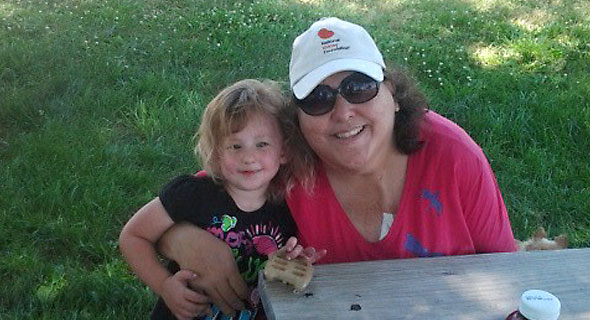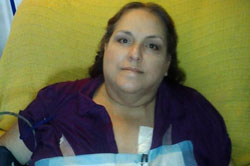
About Amy
| Treatment Type | Nocturnal Home Hemodialysis |
| Gender | Female |
| Age | 50s |
| Marital Status | Married |
| Kids | No / Not at Home |
| Work Status | Working |
| Race | White |
| Pets | No |
| Cause | PKD |
| Travel | No |
| Poor Vision | No |
"I knew I was at risk," says Amy. "My father and grandmother and many aunts and uncles had PKD (polycystic kidney disease)." Amy sat with her dad while he did his hemodialysis (HD) treatments at home, "back in the day, before there were dialysis centers." Do-it-yourself dialysis was a much more common treatment option then. "I would watch my father and we'd talk," recalls Amy. "Those are times I cherish."
Amy learned that she had PKD at 21. For years, Amy had mentally prepared herself for dialysis by doing research and talking to other patients online. Even so, things took her by surprise. Here's what happened.
Urgent start
"My kidney function was around 23% and I thought it would be a few years before I needed dialysis. I hoped I would never need it. Then I had an abscessed tooth pulled—with no antibiotics. And, I never did recover. My urine output had dramatically dropped, so I went in to be checked. A 24-hour urine test showed that my kidney function had fallen to less than 10% in just 3 weeks. I needed to start dialysis right away."
Since Amy had watched her dad, she wasn't too nervous about dialysis itself. But, she was terrified of the needles. "My dad used a shunt, but they don't do that anymore," she added. Her doctor wanted her to have a fistula. Amy remembers thinking to herself, "I can't do this, not with needles."
Amy started dialysis with a catheter in April 2002, the day after she turned 44. She also had a fistula created in her arm. That one failed right away, so she had a second fistula created in her upper arm. It was too deep to reach, so she continued to use a catheter.
Determined to go home

Amy lives, as she describes, "out in the boonies." She would drive a 60 mile round trip 3 days a week to her center for HD. But, she didn't like being at the clinic. "My clinic was one of the better ones, but I always came home worn out and too tired to do much of anything." To cut down on time and travel, and to get more control of her schedule, Amy was determined to try home dialysis. She had a problem, though. She could not find a doctor who would support her on home HD with a catheter.
Amy began to call centers all across Missouri, some even in Kansas and Nebraska, looking for a home program that would train her with a catheter. She saw a TV news segment about a growing home program in Kansas City. She went to see Dr. Bender and his team at the DCI Clinic in Kansas City. "We drove to Kansas City and talked to them for an hour or more," says Amy, "and set up a time to start training for home HD. I was ecstatic!"
Getting started took time. She saw Dr. Bender and his team in September. Then, there was a home visit by the nurses and social worker, and lots of paperwork. Amy started training in November. She and her husband drove 110 miles each way to the clinic 3 days a week for training and her HD sessions. "We were told to plan on at least 12 weeks," recalls Amy. "But, by week 5 we were ready to go home." She and her husband had the water treatment system installed in their house. Amy's new machine (a Fresenius 2008H) was delivered and calibrated. She started doing HD in the comfort of her own home just days before Christmas.
More changes
Amy and her doctor still wanted her to use a fistula.1 So, Amy tried again. She had a transposition surgery to bring a deep vein close to the surface. Three months later, she began to start Buttonholes.2 She and her husband once again drove back and forth to her clinic 3 days a week to have staff help her.
Once the buttonholes were ready and Amy got into a routine, she opted for a new change. She wanted to do her treatments at night. "My dad was doing nocturnal in 1968–70," said Amy, "and he felt pretty good—and that was before EPO!" Amy had also heard from other patients how good they felt with more HD. Doing treatments at night would leave her days free for kids, family and work. At the time, Amy and her husband were home schooling three of their five children.
Amazing results

Amy began nocturnal home HD in 2003. "It was amazing," she reports. "My creatinine went from 9 to 3. I quit taking my binders and my phosphorus went from 6 to 1.2 in just a week. They actually talked of adding phosphorus to my dialysate!" Amy also laughs about the fact that the dietitian urged Amy to eat more dairy and potassium-rich foods.
"The change was a real shock to me in many ways," adds Amy. "You get used to feeling a certain way, a certain level of 'blah,' and think it is okay and normal. You don't realize that you can feel better." She found, instead, that with her longer treatments, she had more energy, mental clarity and vigor to do things she'd written off as impossible. She even found a part-time job at Wal-Mart.
Busy schedule
To fit all of her tasks into the day, Amy has settled on a unique schedule that works for her. Four to six nights per week, Amy's husband, Jeff, helps her hook up to the machine at 8–9 PM. She used to sleep through the night with her HD. But, she has had some problems with the machine, pressures, and sensitivity to the dialyzer and now is awake most nights. So, she watches TV, movies, plays games, or reads until 4–5 AM. Then, she ends her treatment and climbs into bed for 4–5 hours. When she wakes up at around 9 AM, she's ready to head off to work, do chores around their small farm, or tackle housework. "If I get really tired, I might take an extra night off," she admits, "to get some solid sleep."
Overcoming fear
Amy is proud that she was able to get over her fear of needles to do home HD. "The fear is often much worse than the actual event," she claims. She had heard the quote "feel the fear and do it anyway." "I just went headlong into using the needles without any numbing agent. Just cold turkey. It wasn't nearly as bad as the fear I had." Unfortunately, Amy is now back to a catheter. Her Buttonholes worked for about a year. After angioplasties to try to open up narrow spots in her fistula, she got a graft. She then caught a blood infection that put her in the hospital for 5 weeks, and the graft was removed. After two more tries that failed, she has used up her fistula and graft options, and relies on the catheter.
A good choice
"For me, home dialysis has been a great choice," says Amy. She likes the fact that she has more freedom in her treatments and more control, especially if the weather gets bad.
Amy is comforted by the fact that her clinic and nurses are just a phone call away. "The nurses who trained us were by far the most superior professionals I've met. They were truly dedicated to the patient being in control and calling the shots. If we have a problem, they are there to walk us through it," she notes. "If it is something that cannot be solved, we can just unhook and handle it in the morning. Getting more hours of HD lets us disconnect early without any real adverse effects. With standard HD, you don't have that luxury."
She also believes that getting 32–48 hours of dialysis each week instead of 12 is why she feels so well. "Sure, I have my down days, but that's no different than anyone "not" on dialysis. I would recommend it to anyone willing to give it a hearty try. The work is so worth the rewards."
More information
- To learn more about dialysis access, visit Kidney School Module 8: Vascular Access—A Lifeline for Dialysis
- To learn more about the Buttonhole technique for putting needles into fistulas, read Dialysis Needles, Self-cannulation, and the Buttonhole Technique

